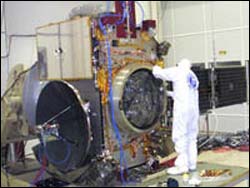STEREO spacecraft arrives at NASA Goddard for final testing

After solar array deployment tests on Observatory B (the one that will be placed “behind” Earth in its orbit around the sun), APL STEREO technicians inspect solar blankets covering the hinges that connect the solar arrays to the spacecraft. Credit: NASA/Johns Hopkins University Applied Physics Laboratory.
The two Solar TErrestrial RElations Observatory (STEREO) spacecraft arrive at the NASA Goddard Space Flight Center in Greenbelt, Md. on Nov. 9 for major testing as they near completion. Set to launch in Spring 2006, STEREO is the first mission to image the sun and solar wind in 3-D. This new view is critical to improving our understanding of space weather and its impact to space and on Earth systems.
During its two-year mission, the two nearly identical spacecraft will explore the origin, evolution, and interplanetary consequences of coronal mass ejections (CMEs), the most violent explosions in our solar system. When directed at Earth, these billion-ton eruptions can disrupt satellites, radio communications, and power systems. In addition, energetic particles associated with CMEs are a serious hazard to spacecraft and astronauts.
“The arrival of both observatories at GSFC is a critical milestone for the STEREO project. The fully integrated observatories look great and represent a lot of hard work from a very dedicated APL/GSFC team. The next few months will be exciting as we put them through a rigorous space simulation test program in preparation for launch,” said Mark Jarosz, Observatory Manager for the STEREO Project at NASA Goddard.
Upon arrival, the spacecraft will undergo multiple mechanical assembly and electrical tests to verify readiness for launch both in a stacked configuration, and on their own. Tests will simulate launch noise, space temperature variations, launch vibrations and validate the explosive nut used to separate the two satellites in orbit. Engineers also plan to deploy the high gain antenna, and ensure that radio emissions from the satellites don’t interfere with other sensitive scientific instruments like the S/WAVES radio astronomy experiment.
STEREO’s launch window extends from April through June 2006 at the Cape Canaveral Air Force Station (CCAFS), Fla. Truly an international effort, its instruments were built and shipped from the United States and several European countries. The observatory integration was performed at The Johns Hopkins University Applied Physics Laboratory (APL) in Laurel, Md. Testing is being conducted both at APL and at NASA.
“STEREO is going to help us answer some of the biggest questions about the sun. Not only will we see if CMEs are moving toward Earth, but we’ll see how they move through the solar system,” said Dr. Michael Kaiser, Project Scientist for STEREO at the Goddard Space Flight Center.
Media Contact
All latest news from the category: Physics and Astronomy
This area deals with the fundamental laws and building blocks of nature and how they interact, the properties and the behavior of matter, and research into space and time and their structures.
innovations-report provides in-depth reports and articles on subjects such as astrophysics, laser technologies, nuclear, quantum, particle and solid-state physics, nanotechnologies, planetary research and findings (Mars, Venus) and developments related to the Hubble Telescope.
Newest articles

Superradiant atoms could push the boundaries of how precisely time can be measured
Superradiant atoms can help us measure time more precisely than ever. In a new study, researchers from the University of Copenhagen present a new method for measuring the time interval,…

Ion thermoelectric conversion devices for near room temperature
The electrode sheet of the thermoelectric device consists of ionic hydrogel, which is sandwiched between the electrodes to form, and the Prussian blue on the electrode undergoes a redox reaction…

Zap Energy achieves 37-million-degree temperatures in a compact device
New publication reports record electron temperatures for a small-scale, sheared-flow-stabilized Z-pinch fusion device. In the nine decades since humans first produced fusion reactions, only a few fusion technologies have demonstrated…





















